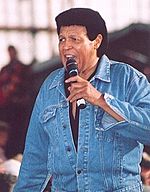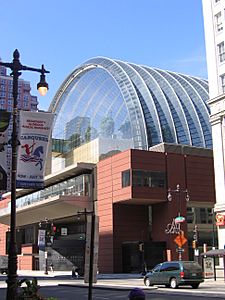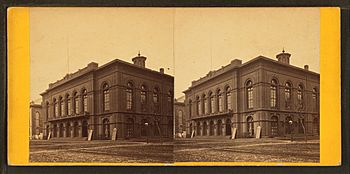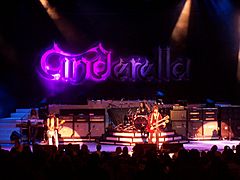Music of Philadelphia facts for kids
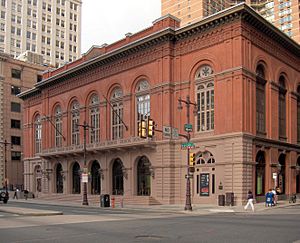
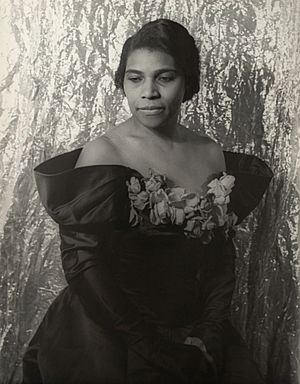
The city of Philadelphia, Pennsylvania, has a rich and long history of music. This musical journey goes all the way back to when the city was first settled. New ideas in classical music, opera, R&B, jazz, and soul have made the music of Philadelphia known around the world.
Philadelphia's music groups have played a big part in the music of Pennsylvania. They also had a huge impact across the country, especially in the early days of hip hop music. Because many different people live in Philadelphia, the city is known for many music styles. These include dancehall and Irish traditional music. It also has a lively classical and folk music scene.
Leopold Stokowski, who was the third conductor of the Philadelphia Orchestra, supported American classical music. He helped bring classical music to many people through tours, recordings, and even in Walt Disney's 1940 film Fantasia. The Curtis Institute of Music was started in 1924. It has trained many famous composers and performers. These include Leonard Bernstein and Samuel Barber. Today, stars like Juan Diego Flórez and Lang Lang also studied there.
The city has also been very important in creating popular music. In the early days of rock and roll, many singers from South Philadelphia became famous. These included Chubby Checker, Frankie Avalon, and Bobby Rydell. This led to the popular dance show American Bandstand being filmed in Philadelphia. Hosted by Dick Clark, teenagers would come after school to dance on TV. They showed off the latest hits to a national audience.
Contents
- Amazing Music Places in Philadelphia
- Fun Music Festivals and Yearly Events
- Philadelphia's Music Story
- Music in Colonial Times (1600s-1700s)
- Music in the 1800s
- Music in the 1900s
- The Philadelphia Orchestra's Rise
- Opera in the 1900s
- Curtis Institute of Music's Legacy
- Chamber Music Scene
- Choirs and Choral Groups
- Popular Music Takes Off
- Punk Rock and Beyond
- Gospel Music's Roots
- Irish Music Flourishes
- Jazz in the City of Brotherly Love
- 1950s Pop Music Explosion
- The Philly Soul Sound
- Modern Music Scene
Amazing Music Places in Philadelphia
Philadelphia has many different places where you can enjoy music. The oldest and most famous is the Academy of Music. It opened in 1857 and is the oldest opera house in the United States that is still used for its original purpose. The Academy is a central part of Philadelphia's music scene. It is home to groups like the Philly Pops and the Opera Company of Philadelphia. It also hosts touring artists and musical plays.
The newest big music venue is the Kimmel Center for the Performing Arts, which opened in 2001. This is where the world-famous Philadelphia Orchestra performs. The Philadelphia Singers often join the orchestra for concerts. The Kimmel Center also hosts the Chamber Orchestra of Philadelphia and the Philadelphia Chamber Music Society. This society brings famous performers and local groups to the city.
Another very important place is the Mann Center for the Performing Arts. It is one of the biggest outdoor music venues in the United States. The Mann Center opened in 1976 and is the summer home for the Philadelphia Orchestra. It also hosts major touring artists from all kinds of music. It is Philadelphia's main spot for popular entertainers. Just outside Philadelphia, the Tower Theater in Upper Darby also brings in many top touring acts.
The Annenberg Center for the Performing Arts is another important venue. It started in 1971 and includes several theaters. The center offers over 170 performances each year. These include concerts, plays, and dance shows.
Philadelphia has a lively jazz scene. This is thanks to groups like the John W. Coltrane Cultural Society. This group honors local jazz legend John Coltrane and helps promote jazz in the city. Many nightclubs in Philadelphia host live music. Warmdaddy's has been a popular spot for jazz and blues for over 40 years. The city is also home to the Clef Club of Jazz and Performing Arts. It is known as the first club built just for jazz. World Cafe Live (WCL) opened in 2004. This music hall, restaurant, and bar has hosted artists like George Clinton and Natalie Cole.
Philadelphia's many different ethnic groups have also created organizations to share their music. These include the Asian Arts Initiative and the Latin American Musicians Association (AMLA). The AMLA was started in 1982 to promote Latino music and musicians. It runs a Latin School of Arts with teachers like Elio Villafranca. The Italian American Broadcasting Network in Philadelphia plays Italian music on local radio stations like WPHT. The Painted Bride Art Center supports alternative and avant-garde music. Crossroads Music focuses on music from different cultural traditions around the world.
Other local music groups include the Philadelphia Gay Men's Chorus, started in 1981. The Mendelssohn Club is a choral group that began in the 1800s. The Philadelphia Youth Orchestra is one of the best children's music groups in the United States. It has performed worldwide since 1939.
A special musical attraction in Philadelphia is the Wanamaker Organ. It is located in the Macy's department store downtown. This huge organ was built in 1904. It was so big that it needed 13 freight cars to bring it to Philadelphia. Once here, more pipes were added, making it even larger. Today, it has 28,500 pipes. Some pipes are 32 feet long, and others are tiny, only a quarter-inch long. You can hear performances on the Wanamaker Organ twice a day, Monday through Saturday.
Fun Music Festivals and Yearly Events
Philadelphia hosts many exciting music festivals. These include the West Oak Lane Jazz Festival (every June) and the Bach Festival of Philadelphia (since 1976). There is also the old and famous Philadelphia Folk Festival. Many summer concert series and cultural festivals happen at Penn's Landing. One is the Smooth Jazz Summer Nights Series in August. The Jazz on the Ave Music Festival (since 2006) takes place in mid-August. It features jazz, soul, gospel, R&B, and modern urban music. The Philadelphia Céilí Group promotes Irish music. They run a festival that they say is one of the oldest continuous Irish traditional festivals in the United States. Near the city, the annual Concerts Under the Stars summer festival takes place in Upper Merrion township.
Perhaps the most famous yearly music event in Philadelphia is the Mummers Parade. This celebration happens on New Year's Day. It features amazing costumes, old-time string bands, and other fun entertainment. This tradition started in the mid-1600s. Finnish and Swedish settlers in Philadelphia celebrated holidays by shooting muskets. Over the years, their parade grew and became more diverse. The Mummers tradition became official in 1901. It has happened every year since, except for two. A Mummers' string band is a large group of musicians. They play banjos, violins, saxophones, and drums. They create an "old-fashioned, tinny sound" like the popular music from 1900 and earlier.
Philadelphia's Music Story
The very first music in the Philadelphia area came from the indigenous peoples. However, we don't know much about their music. The city was founded in 1682 by William Penn from England. He wanted it to be a safe place for people facing religious persecution. Because of this, much of the city's early music history is linked to religious music. German immigrants were very important in creating a lively music culture in churches. They also helped with music publishing in the early 1700s.
While non-religious music was played in homes and private clubs, public performances didn't start until the 1750s. At that time, Philadelphia became the main cultural center in the Thirteen Colonies. It then became important in the new United States. The city gained a reputation for classical music by Joseph Haydn and Wolfgang Amadeus Mozart. It had the best opera and theater scene in the U.S. in the late 1700s.
In the 1800s and early 1900s, Philadelphia's population grew more diverse. Immigrants from Ireland, Russia, and Italy arrived. Philadelphia became a regional center for Italian music. It also produced many good Irish musicians. The city's large Jamaican population brought their own music styles, like dancehall. This became a big part of Philadelphia's nightlife in the early 2000s.
Music in Colonial Times (1600s-1700s)
Religious Music's Start
Philadelphia became a key music center in North America during the colonial era. Early music was mostly made in churches and homes. The first settlers were English Quakers who weren't very focused on music. But William Penn welcomed other religious groups, which helped music grow. German immigrants started arriving around 1700. They brought instruments, built organs, and wrote hymns.
Some of the first printed sheet music came from these German immigrants. More than 20 German-language hymnals were printed before 1750. By the mid-1700s, Philadelphia was the top center for music printing in the New World. One of the oldest English hymnbooks from the U.S. was printed in 1741 by Benjamin Franklin. It was Isaac Watts' Hymns and Spiritual Songs.
Colonial Pennsylvania was home to several religious groups. Some played a big role in music. German Pietists settled near Philadelphia in 1694. They lived along the Wissahickon Creek and were called the Hermits of the Wissahickon. Their leader, Johannes Kelpius, wrote hymns. These hymns were translated into English by Christopher Witt. He was a painter and musician who built one of the first private organs in the colonies.
Philadelphia has also been a major center for Roman Catholic church music. The first Catholic hymnbook in the U.S. was published here in 1787. It included music for different voices. The publisher Mathew Carey was very important. He published a catechism in 1794 that later included hymns.
Non-Religious Music Takes the Stage
Early non-religious music was first played in homes or private clubs. The first known private concert was in 1734. The first public concert happened in 1757. Concerts with a chamber orchestra started that year. They featured music by English, Italian, German, and Bohemian composers. This was largely thanks to Governor John Penn and Francis Hopkinson. Hopkinson signed the Declaration of Independence and was a composer.
After the American Revolutionary War, many professional musicians from Europe came to Philadelphia. Rayner Taylor, Alexander Reinagle, and Benjamin Carr were key figures around 1800. They came from England and were performers, composers, conductors, teachers, and concert managers. Susannah Haswell Rowson was an important female composer. She wrote words for Reinagle's music and was a successful poet, guitarist, singer, and actress. Benjamin Franklin was also a musician. He taught guitar and invented instruments like the glass armonica. In 1784, Andrew Adgate started the Uranian Academy. This school was the center of the city's choral music scene in the late 1700s.
The first known musical play in Philadelphia was Flora, or Hob in the Well in 1754. It was performed by a touring opera company. In 1757, Francis Hopkinson put on a big show of Thomas Arne’s Alfred. The Society Hall Theatre (built 1759) and the Southwark Theatre (opened 1766) staged plays and operas. Even though some religious groups were against theater, comic operas from British composers were often performed.
During the Revolutionary War, expensive theater shows were banned. The ban lasted until 1789. After it was lifted, Philadelphia became a main theater center. The New American Company, started in 1792, brought many singers and composers from England. While most shows were from London, some local composers wrote original operas. These included Carr's The Archers (1796) and Reinagle's The Volunteers (1795). The New Theatre (later Chestnut Street Theatre) was built in 1793. It was the most splendid theater in the U.S. at the time. It seated nearly 2000 people. Several Mozart operas, like Don Giovanni, had their U.S. debut there.
Music in the 1800s
Philadelphia's Holy Trinity Church published the first German-American Catholic catechism in 1810. Benjamin Carr, music director of St. Augustine's Catholic Church, also published hymnbooks. His 1805 work introduced "O Sanctissima" and "Adeste Fideles" to American Catholics. The Catholic Church in Philadelphia started important music schools in the early 1800s. These included a singing school and a boys' choir. Throughout the 1810s, works by Ludwig van Beethoven, like his Eroica Symphony, premiered in Philadelphia.
Philadelphia's African American music history dates back to colonial times. It gained fame with Frank Johnson, who moved to Philadelphia around 1809. Johnson wrote popular marches and quadrilles. He even performed for Queen Victoria in 1837. By the late 1800s, African Americans in Philadelphia had their own music groups, including a symphony orchestra.
With the start of the Musical Fund Society in 1820, music activity in Philadelphia grew a lot. By the mid-1800s, the city was a national center for music. Religious music changed, and new styles like English opera became popular. The first American grand opera, Leonora by William Henry Fry, premiered in Philadelphia in 1845. It was so admired that it was performed 16 times that season.
Philadelphia's Academy of Music, known as the "Grand Old Lady of Broad Street," was founded in 1855. When it opened, it was the best opera house in the United States. It was designed like La Scala in Italy, with three balconies and nearly 3000 seats. The first opera performed there was Giuseppe Verdi's Il Trovatore in 1857. The Academy of Music is the oldest opera house still in use in the U.S. It was named a National Historic Landmark in 1963. It was the main concert hall until the Kimmel Center for the Performing Arts opened in 2001. Many first American performances happened there, including Charles Gounod's Faust (1863).
In the late 1800s, two more opera houses opened: the Chestnut Street Opera House (1885) and the Grand Opera House (1888). With three venues, the city could attract touring companies with the best European stars. Many American premieres were directed by Gustav Hinrichs at the Grand.
The city's first important orchestra, the Germania Orchestra, was founded in 1856. It gave yearly concerts until 1895. The conductor Theodore Thomas also presented concerts. During the 1876 American independence celebration, the Thomas Orchestra gave concerts.
Philadelphia's large German population supported several singing groups. While some have closed, others like Harmonie (1855) are still active. Other important early choirs included the Abt Male Chorus. Two choirs still active today are the Orpheus Club of Philadelphia, America's oldest men's chorus of its kind (founded 1872), and the Mendelssohn Club, founded in 1874.
In the 1800s, Philadelphia was a key center for popular music. By the late 1800s, over 100 composers were writing songs and dances. Minstrel shows were very popular. In 1855, the first black minstrel theater opened. Local performer James A. Bland wrote very successful songs like "Carry Me Back to Old Virginny" (1878). "Oh, dem Golden Slippers" (1879) became the theme song of the Mummers. They started clubs and officially began their yearly tradition in 1901. They dress in fancy costumes and parade on New Year's Day, playing banjos, guitars, and saxophones.
Music in the 1900s
The Philadelphia Orchestra's Rise
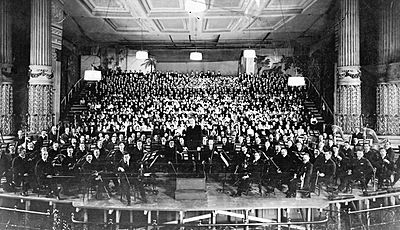
The Philadelphia Orchestra started in 1900. For much of its history, it was considered one of the best American orchestras. It was one of the "Big Five" American groups. It was first led by Fritz Scheel. But it was the conductor Leopold Stokowski who made the Orchestra famous. Stokowski shared the conductor's role with Eugene Ormandy starting in 1936. Ormandy took over completely in 1938.
Under Stokowski and Ormandy, the Philadelphia Orchestra made many famous recordings. This included the music for the 1940 Disney film Fantasia. The Orchestra, led by the lively "Stokie," toured a lot both nationally and internationally. It became the model for modern classical orchestras in the 1900s. After Stokowski left, Ormandy led the Orchestra into the 1970s. He kept its beautiful sound and played popular classical music. The Orchestra became the first American orchestra to visit China. They performed in the Great Hall of the People in Beijing. This tour was very popular and has been repeated three times.
In the 1900s, the Orchestra was the first to make electric recordings. It was also the first to have its own radio show. It was the first to play music for a movie (The Big Broadcast). It was the first to appear on national television. It recorded all of Beethoven's symphonies on CD. It also gave a live concert online and toured Vietnam.
Opera in the 1900s
The Philadelphia Opera House was built quickly in 1908 by Oscar Hammerstein I. It was first home to Hammerstein's own opera company. But it was sold to the Metropolitan Opera of New York City in 1910. The Met Opera performed in Philadelphia for nearly 80 years. They brought their whole company to the city on certain nights. They mostly performed at the Academy of Music. In 1961, the Met's regular visits stopped after almost 900 performances.
After World War I, many local opera companies started in Philadelphia. The Pennsylvania Grand Opera Company and the Philadelphia Civic Opera Company closed due to the Wall Street Crash of 1929. The Philadelphia Grand Opera Company was the name of four different companies. The last and most famous one started in 1954. It later joined with the Philadelphia Lyric Opera Company in 1975. This formed the city's only current grand opera company, the Opera Company of Philadelphia. The city's music schools also regularly put on operas.
Curtis Institute of Music's Legacy
The Curtis Institute of Music was founded in 1924. It is a classical music school. It was started by Mary Louise Curtis Bok. Curtis has trained some of the world's best composers and musicians. These include Samuel Barber, Leonard Bernstein, and pianists like Abbey Simon. Today, famous performers like Lang Lang are also Curtis graduates. Well-known composers who studied at Curtis include Jennifer Higdon. Famous teachers at Curtis have included pianists Jozef Hofmann and Rudolf Serkin.
Chamber Music Scene
Philadelphia has also had a busy chamber music scene. One of the most famous groups in the early 1900s was the Curtis String Quartet (1932–81). Its members were Curtis Institute graduates. The quartet traveled widely and made many recordings. The Philadelphia String Quartet was formed in 1959. Its members were from the Philadelphia Orchestra. The Concerto Soloists (founded 1964) were the city's main professional chamber orchestra. It later became the Chamber Orchestra of Philadelphia. The Philadelphia Chamber Music Society, started in 1986, brings famous chamber groups and soloists to the city.
Choirs and Choral Groups
Several notable local choirs existed in the city during the 1900s. The Philadelphia Choral Society (1897–1946) was the city's main choir for many years. Other past choirs include The Treble Clef Club and the Palestrina Choir. Still active today are the Mendelssohn Club of Philadelphia (1874) and Singing City (1947). The Philadelphia Singers, founded in 1971, was the city's main professional choir but closed in 2015. The Philadelphia Boys Choir & Chorale has been the city's top boys' choir since 1968.
Popular Music Takes Off
Philadelphia also produced new and exciting performers in pop, punk rock, soul, and jazz. In the mid-1950s, as rock and roll grew, Philadelphia started hosting the TV show "American Bandstand". This show changed popular music. It brought rock and roll stars to West Philadelphia. School kids danced after school at 46th and Market Streets. Dick Clark hosted the show. The city produced some of early rock's most famous singers. These included Chubby Checker, Frankie Avalon, and Bobby Rydell.
Philadelphia's jazz history is important. John Coltrane, one of the most creative performers of the 1900s, moved to the city after graduation. The Philly soul sound of the 1970s was also a very important part of national music.
Punk Rock and Beyond
The city also has a strong history with local indie rock and punk. The punk band Pure Hell formed in the 1970s. The 1980s saw a local New Wave scene with bands like Johnny's Dance Band. There were also hardcore punk bands. In the 90s, indie rock bands like Dead Milkmen became more nationally popular. The Dead Milkmen led a satire punk era on MTV. The city also had an electronic music scene with acts like Dieselboy.
Gospel Music's Roots
Philadelphia's gospel music history goes back to Charles Albert Tindley. He was a local reverend who wrote many important hymns. Tindley's "I Do, Don't You" inspired composer Thomas A. Dorsey. Dorsey said Tindley helped create gospel music. Tindley wrote most of his works between 1901 and 1906. He was known for his powerful preaching.
Philadelphia has produced many popular gospel acts. The most famous is singer Clara Ward. Ward became famous after a performance in Philadelphia in 1943. She formed a group with other local singers. The Clara Ward Singers were known for bringing style and glamour to gospel music.
The Dixie Hummingbirds are also one of Philadelphia's most famous international quartet groups. They are still performing today. Since the 1920s, this group has been known as "The Gentlemen of Song." Their white tail suits and unique harmony keep gospel quartet music alive.
Irish Music Flourishes
Philadelphia became home to many Irish immigrants in the 1840s. More arrived throughout the late 1800s and 1900s. These immigrants brought many styles of traditional Irish music, like jigs and reels. Starting in the late 1940s, Philadelphia's Irish music scene grew fast. This was partly due to live music broadcasts by Austin Kelly and the All-Ireland Irish Orchestra on WTEL radio station.
Modern Philadelphia has produced important Irish musicians. These include Mick Moloney, John Vesey, and Séamus Egan. They were part of a national rise in interest in traditional Irish-American music. In Philadelphia, this revival built on the work of earlier pioneers like Ed Reavy, a composer from the 1930s.
Mick Moloney is Philadelphia's most famous contribution to Irish traditional music. He was from County Limerick, Ireland. He played the banjo and sang. He also lectured widely on Irish culture and music. He founded Green Fields of America, which promotes Irish-American music. Egan is a multi-instrumentalist from Philadelphia. He co-founded the Irish music band Solas. He also co-wrote Sarah McLachlan's hit song "I Will Remember You."
Jazz in the City of Brotherly Love
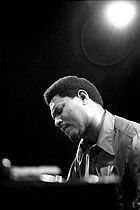
Philadelphia developed an early jazz scene. Ethel Waters, a singer from nearby Chester, Pennsylvania, was the first star for Black Swan Records. The Standard Theatre and Dunbar Theatre were important jazz venues in the early 1900s. Most major performers stopped in Philadelphia. Even though jazz came from African American gospel and blues, Philadelphia's diverse population loved it. The city's Italian and Jewish neighborhoods produced famous jazz musicians. Two of the most important were Eddie Lang and Joe Venuti. Venuti was known as the "Mad Fiddler from Philly."
Philadelphia's African American population grew a lot during World War II. Many future stars like the Heath Brothers and John Coltrane moved to Philadelphia. Philadelphia's mid-1900s jazz played a big role in developing bebop. In the 1940s, Philadelphia jazz was centered in clubs along Columbia Avenue in North Philadelphia. It was also in clubs like the Clef Club in South Philadelphia. The city produced many bop-era saxophonists. The most famous was John Coltrane. He was known for his "active, vigorous, emotionally charged style."
In 1970, Sun Ra's band made Philadelphia its home. This helped set the stage for the 1980s scene. That era produced Grover Washington, Jr. and Stanley Clarke. The 1990s jazz scene continued to thrive with artists like Tim Warfield and Christian McBride.
The city has a lively jazz radio station, WRTI, sponsored by Temple University. Its hosts include Bob Perkins. The Peco Energy Jazz Festival is held every February.
1950s Pop Music Explosion
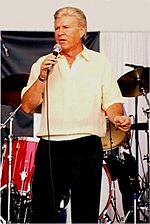
Philadelphia's first big impact on American pop music was the TV show American Bandstand. Dick Clark hosted it. The show featured music and dancing teenagers. It became a lasting part of American culture. It was groundbreaking for showing rock and roll in the mid-1950s. American Bandstand brought attention to Philadelphia's music scene. It helped local labels like Swan Records and Cameo-Parkway grow. This led to pop stars like Fabian, Bobby Rydell, and Frankie Avalon. The show moved to Los Angeles in 1963, and Philadelphia's pop music slowed down.
Philadelphia's 1950s music included rock pioneer Bill Haley from Chester, Pennsylvania. It also had rockabilly musician Charlie Gracie. Philadelphia also had a lively R&B and soul scene. The Cameo-Parkway label was very important. It produced 1950s R&B dance hits like Chubby Checker's "The Twist." Cameo-Parkway followed with other dance songs like "The Wah-Watusi" by The Orlons.
Philadelphia's famous 1950s performers also included Danny & the Juniors, a doo wop group. They were among the first doo wop musicians from Philadelphia to become nationally successful. Doo wop was a style of a cappella vocal music. It was popular in many East Coast cities, including Philadelphia.
The Philly Soul Sound
In the 1960s, Philadelphia soul started to develop its own sound. It had "strong pop melodies and brassy, upbeat production." Other performers, like Howard Tate, had a more Southern soul sound. Important girl groups included Brenda & the Tabulations. Patti LaBelle was the most influential of these performers. She became a major pop singer in the 1970s.
R&B and soul labels in the 1960s included Phil-LA and Arctic Records. This is where the songwriting and producing team of Kenny Gamble and Leon Huff began. Gamble and Huff created the Philadelphia sound in soul music. Their signature sound was sentimental and romantic. It started with The Intruders. Jerry Butler became an important performer later. Gamble and Huff experimented with a rich, orchestral sound. This was "more removed from earlier soul's R&B and blues roots." Thom Bell also worked with groups like The Delfonics and The Stylistics.
In the early 1970s, Philly soul became very popular. Gamble and Huff's Philadelphia International label signed a deal with CBS. The O'Jays became the first major act. They were known for songs about inner-city life like "Back Stabbers." They were followed by the more romantic Harold Melvin & the Blue Notes. This group featured future solo singer Teddy Pendergrass. Philadelphia International also released music by Billy Paul and MFSB.
By the early 1980s, Philadelphia soul became less popular. Audiences loved disco. Philadelphia's main contribution to disco was Patti LaBelle. The city remained musically important. It produced the popular blue-eyed soul duo Hall & Oates.
Modern Music Scene
In the late 1900s and early 2000s, Philadelphia's music scene produced many respected performers. They came from jazz, R&B, rock, hip hop, and dancehall. The city's most important contribution to popular music since the 1980s was its role in the early growth of East Coast hip hop. This style started in New York City. More recently, Philadelphia's large Jamaican population has led to many dancehall and reggae clubs. Grindcore, industrial music, and hardcore punk are also part of Philadelphia's modern music scene. This scene is built around labels like Relapse.
Classical Music Today
Philadelphia has a thriving classical music scene. Many orchestras, choirs, chamber groups, and new music groups call it home. Several famous composers live in Philadelphia, including Jennifer Higdon.
Electronic Music Beats
Philadelphia has a diverse DJ scene for electronic dance music. It's centered in an area called Vinyl Row on Fourth Street. Most major events are advertised here. DJ clubs include Fluid and Shampoo. Some of the city's prominent DJs are Rob Paine and Tom Colontonio.
Philadelphia's electronic music scene includes DJs who play house and techno. But the city is especially known for the techstep style of drum and bass. It is home to one of the country's most popular DJs of that style, Dieselboy. Local performers include Jordana LeSesne and Karl K. In 2010, Bryon Stout launched Philadelphia's first successful house music internet radio station, Deephouselounge.com.
Hip Hop's Philadelphia Story
The first major pop hip hop acts from Philadelphia were Will Smith and DJ Jazzy Jeff. The city also produced other noted performers, like Tuff Crew and Lisa Lopes of TLC. Local hip hop recording began in the late 1970s with Lady B.
However, it was Schoolly D who first put Philadelphia on the hip hop map. He made Philadelphia "the starting point for a whole new direction in rap music." Schoolly D is often seen as the first hardcore rapper and gangsta rapper. He became famous locally with his song "P.S.K. What Does It Mean?." He rapped about life in the ghetto and dealing with poverty and crime.
Even though Philadelphia is a birthplace of hardcore rap, the upbeat Will Smith became the most visible early star. However, the local scene is still lively. There are regular performances across the city. Some performers have gained national fame since Smith. These include The Roots, Cassidy, Beanie Sigel, Meek Mill, and Eve. The city has also produced the well-known alternative hip hop duo Jedi Mind Tricks and Lil Uzi Vert.
Jamaican Music Influence
Philadelphia has the sixth-largest Jamaican population of any U.S. city. Jamaican music clubs, playing styles like dancehall, have become a big part of Philadelphia's nightlife. Clubs like Upper Deck and Genesis are mainstays of the dancehall scene. Many of these clubs hold dancehall contests.
R&B and Neo Soul Vibes
Philadelphia has been a key center for the neo soul movement in R&B. This includes acts like Jill Scott, Jazmine Sullivan, and Musiq Soulchild. Neo-soul star John Legend attended the University of Pennsylvania and still has ties to the city. More recently, Philadelphia is still home to smooth neo-soul sounds. Vocalists like Rosa Nice have topped local independent music charts.
Rock and Indie Music Scene
Rock and Roll arguably started with Bill Haley and the Comets. They played regularly in Gloucester City, NJ, just across the river from Philadelphia, in the early 1950s. The city and its suburbs have since been home to influential rock artists like Joan Jett. Many bands call Philadelphia home. The area is highly regarded by rock bands and artists.
The area includes critically acclaimed rock and metal bands. These include A Life Once Lost, Cinderella, Circa Survive, and Valencia. Other popular rock and indie rock musicians from Philadelphia include G. Love and Special Sauce, Amos Lee, Man Man, Dr. Dog, Kurt Vile, and The War on Drugs. Musicians from popular bands like Clap Your Hands Say Yeah and The Walkmen are also from Philadelphia.
|


